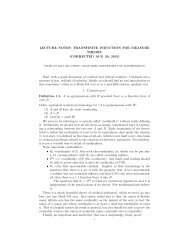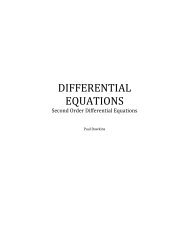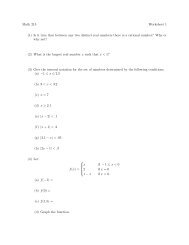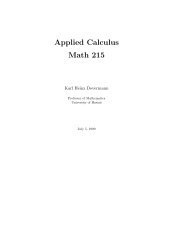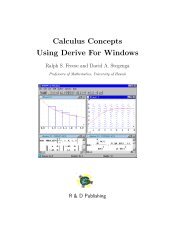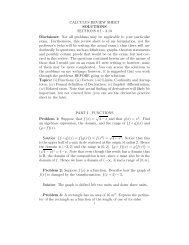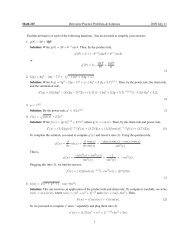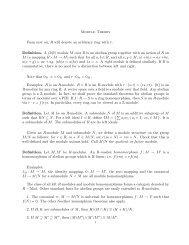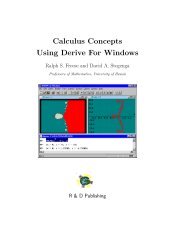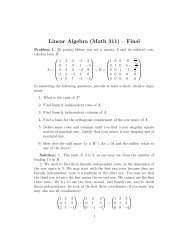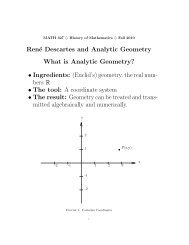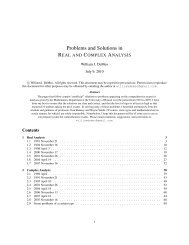MA thesis available - University of Hawaii
MA thesis available - University of Hawaii
MA thesis available - University of Hawaii
Create successful ePaper yourself
Turn your PDF publications into a flip-book with our unique Google optimized e-Paper software.
6 M. CHI<br />
(1) We have<br />
<br />
aτ + b<br />
f = (cτ + d)<br />
cτ + d<br />
k f(τ),<br />
<br />
a b<br />
for all τ ∈ H and all ∈ Γ.<br />
c d<br />
(2) If γ ∈ SL2(Z), then (f|kγ)(τ) has a Fourier expansion <strong>of</strong> the form<br />
(f|kγ)(τ) = <br />
aγ(n)q n N,<br />
Remark 1.<br />
where qN := e 2πiτ<br />
N and aγ(nγ) = 0.<br />
n≥nγ<br />
(1) Condition (2) <strong>of</strong> Definition 3 means that f(τ) is meromorphic at the cusps <strong>of</strong> Γ. If<br />
nγ ≥ 0 for each γ ∈ SL2(Z), then we say that f(τ) is holomorphic at the cusps <strong>of</strong> Γ.<br />
(2) Condition (1) may be rewritten as (f|kγ) = f for all γ ∈ Γ.<br />
(3) By [13, III.3 Modular forms for congruence subgroups], the function f|kγ is periodic<br />
with period N for γ ∈ SL2(Z)/Γ.<br />
(4) One uses only even integers k in the definition above since it is easy to check that<br />
there are no non-zero modular forms <strong>of</strong> odd weight.<br />
Definition 4. Suppose that f(τ) is an even integer weight meromorphic modular form on<br />
a congruence subgroup Γ0(N).<br />
We say that f(τ) is a holomorphic modular form if f(τ) is holomorphic on H and is<br />
holomorphic at the cusps <strong>of</strong> Γ0(N).<br />
We say that f(τ) is a holomorphic cusp form if f(τ) is holomorphic on H and vanishes<br />
at the cusps <strong>of</strong> Γ0(N).<br />
We say that f(τ) is a weakly holomorphic modular form if it is holomorphic on H<br />
with possible poles in cusps <strong>of</strong> Γ0(N).<br />
When Γ = Γ0(N) is a subgroup <strong>of</strong> SL2(Z), we put<br />
Mk(Γ) = { f: f is a holomorphic modular form <strong>of</strong> weight k on Γ},<br />
Sk(Γ) = { f: f is a cusp form <strong>of</strong> weight k on Γ},<br />
M ! k (Γ) = { f: f is a weakly holomorphic modular form <strong>of</strong> weight k on Γ}.<br />
Let q = e2πiτ with τ ∈ H . One <strong>of</strong> the first classical examples <strong>of</strong> a cusp form is<br />
∆ = q <br />
(1 − q n ) 24 ∈ S12(Γ0(1)).<br />
n≥1<br />
Mk(Γ) and Sk(Γ) are finite dimensional vector spaces. M ! k (Γ) is an infinite dimensional<br />
vector space. Sk(Γ) has a basis {gi} such that gi = ∞ n=1 ci(n)qn with ci(n) ∈ Z. The<br />
latter fact is rather difficult to prove, and we take it for granted. This fact has several<br />
implications. Let f = <br />
n≫−∞ a(n)qn ∈ M ! k (Γ) be a modular form such that all coefficients<br />
a(n) are algebraic numbers. Then there is an algebraic number field K (i.e. a finite extension<br />
<strong>of</strong> Q) such that a(n) ∈ K for all n. Moreover, there exists T ∈ K such that T a(n) ∈ OK, the<br />
ring <strong>of</strong> integers <strong>of</strong> K, for all n. The latter statement is <strong>of</strong>ten called “bounded denominators




